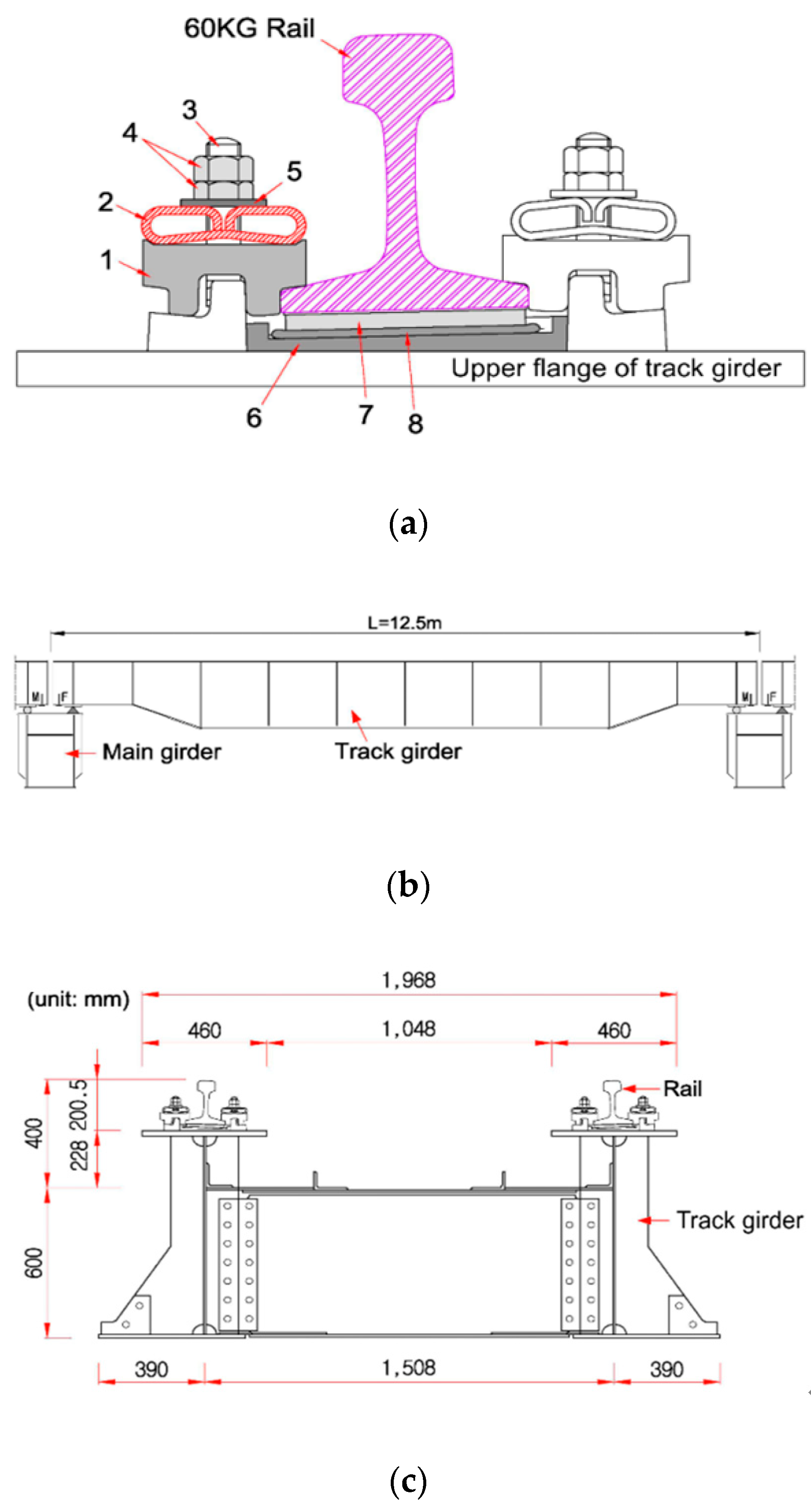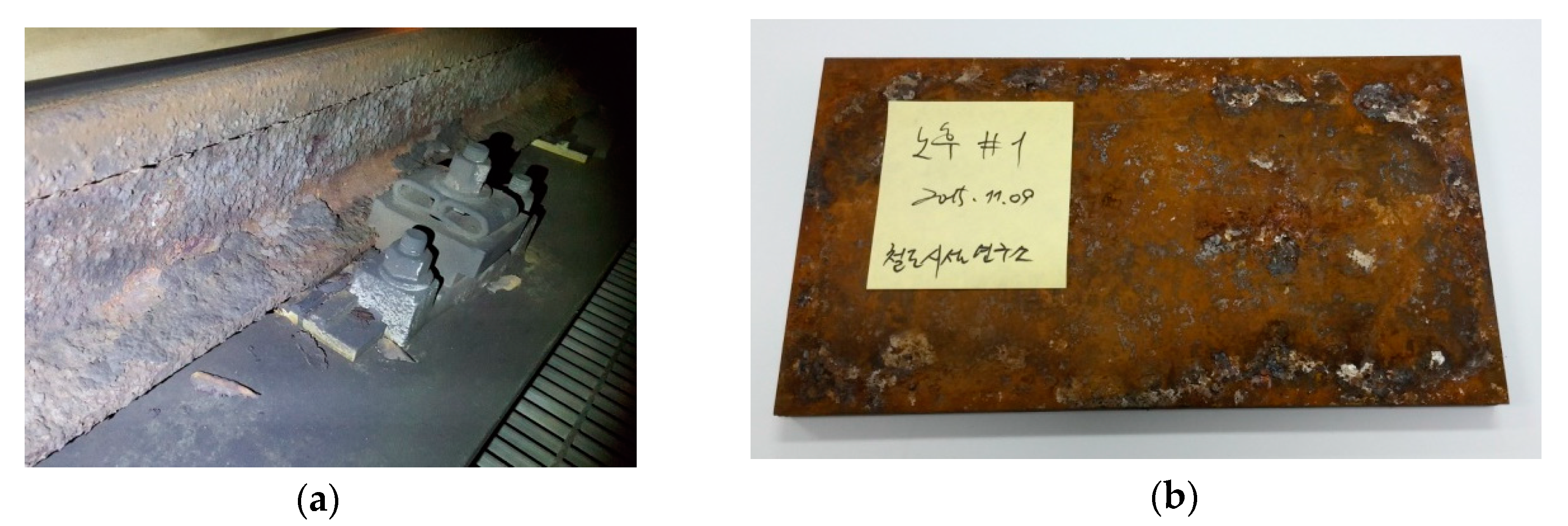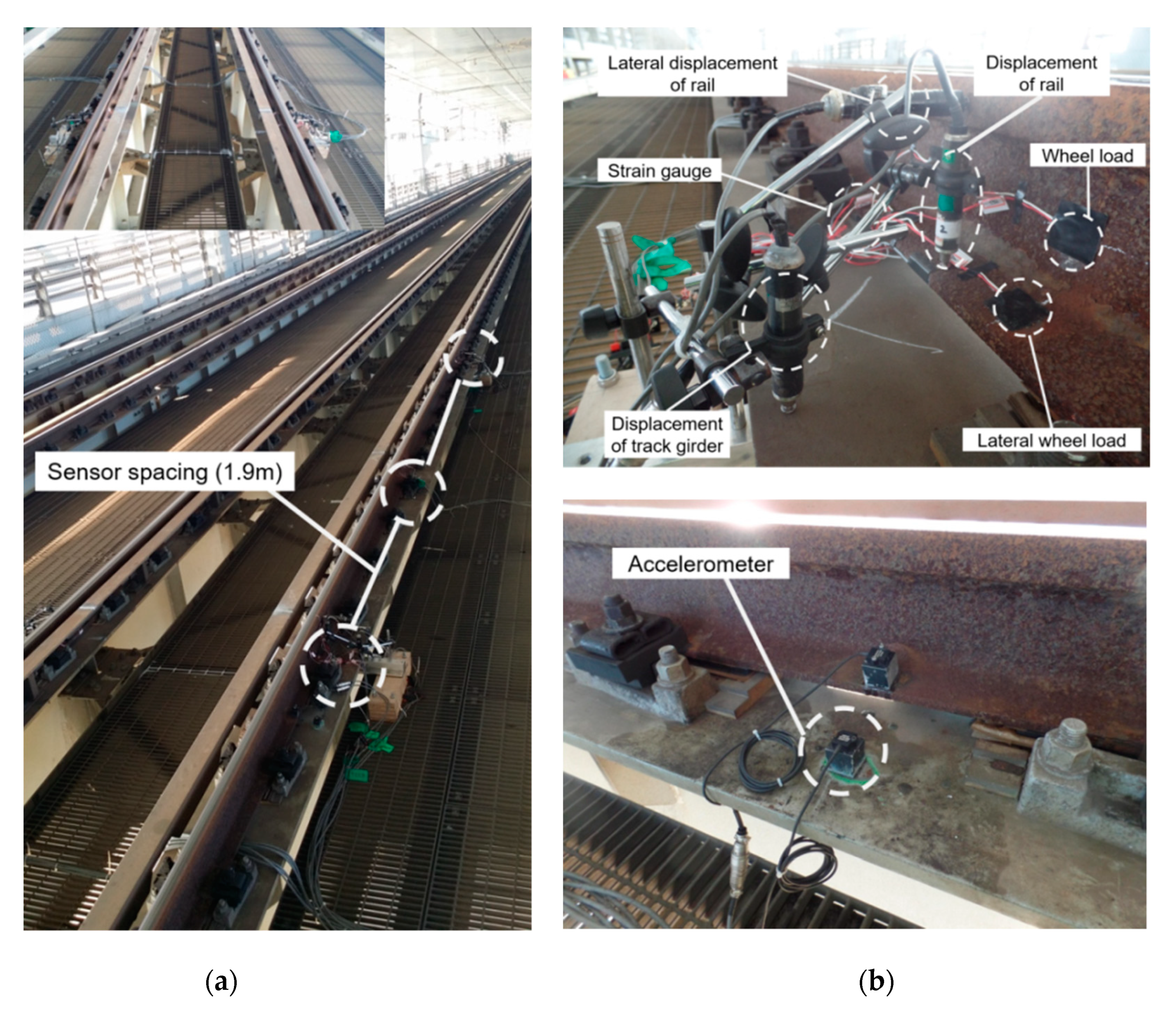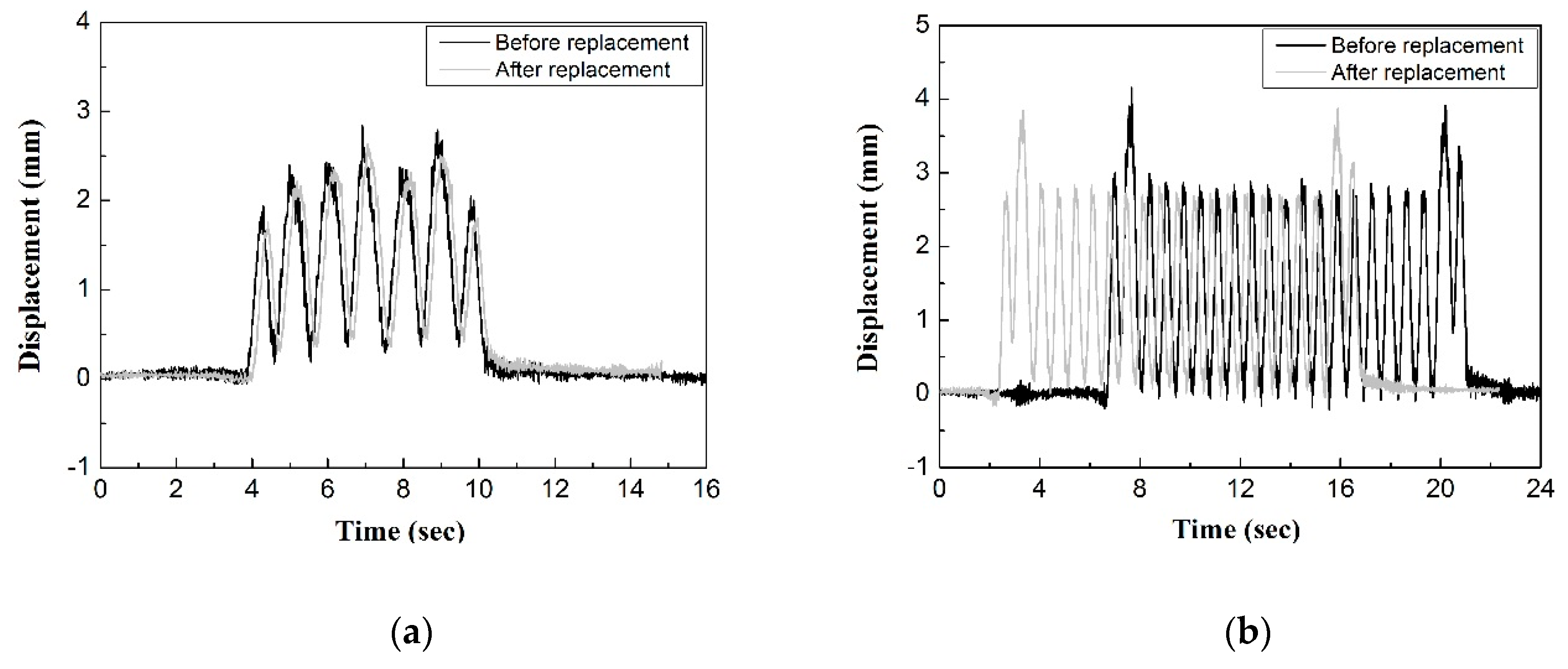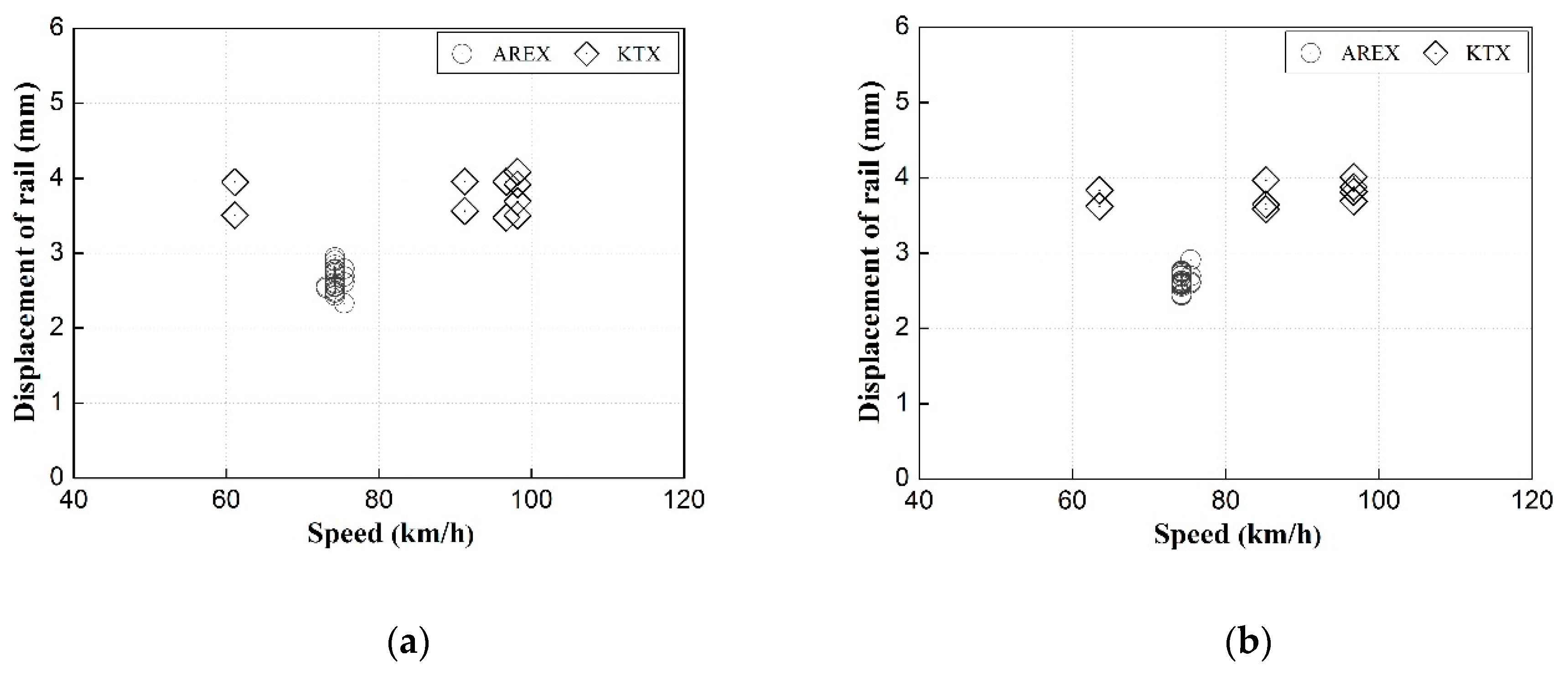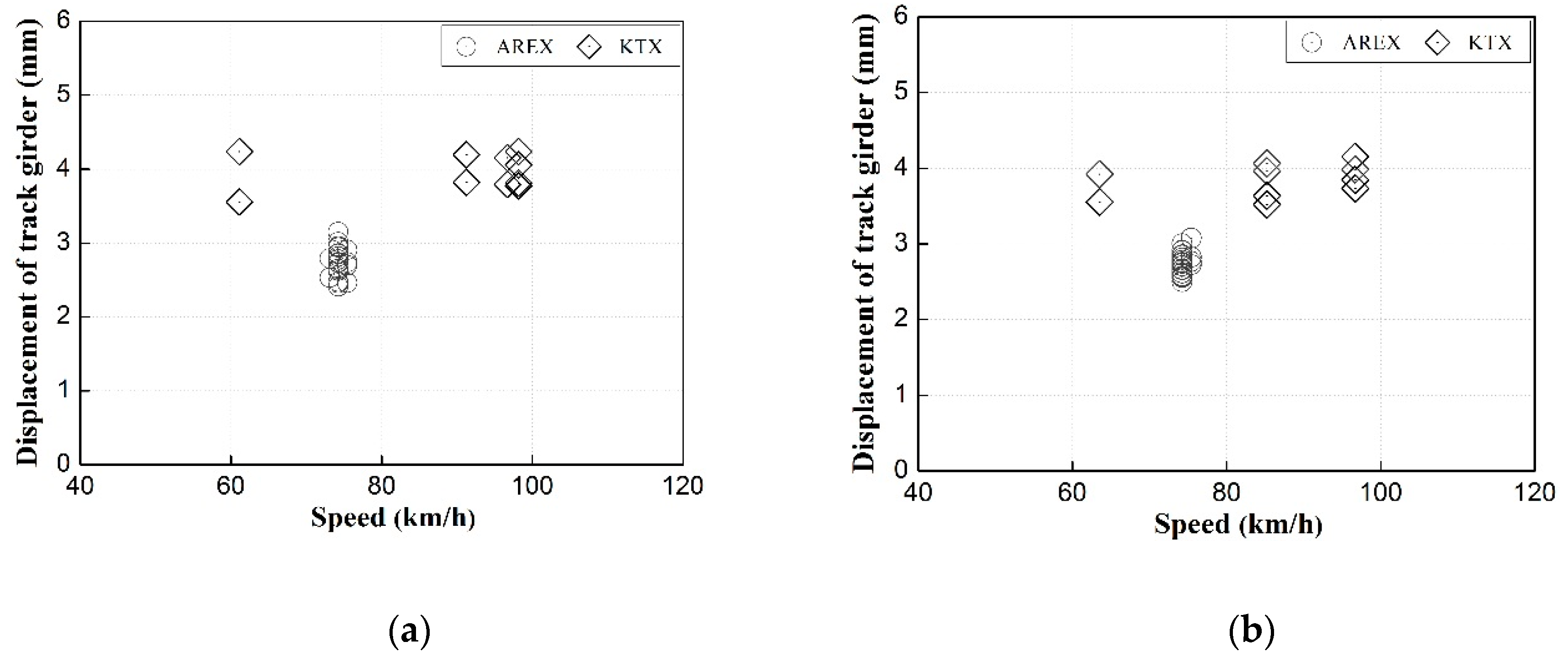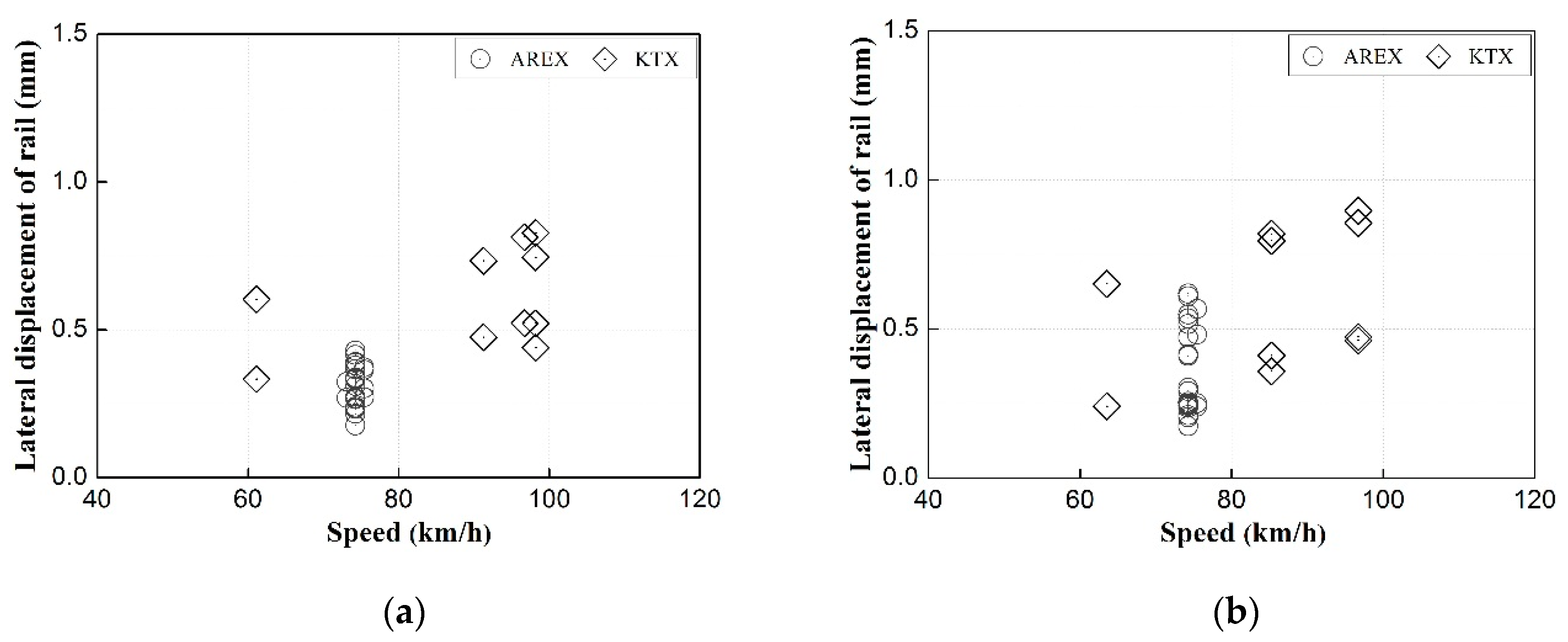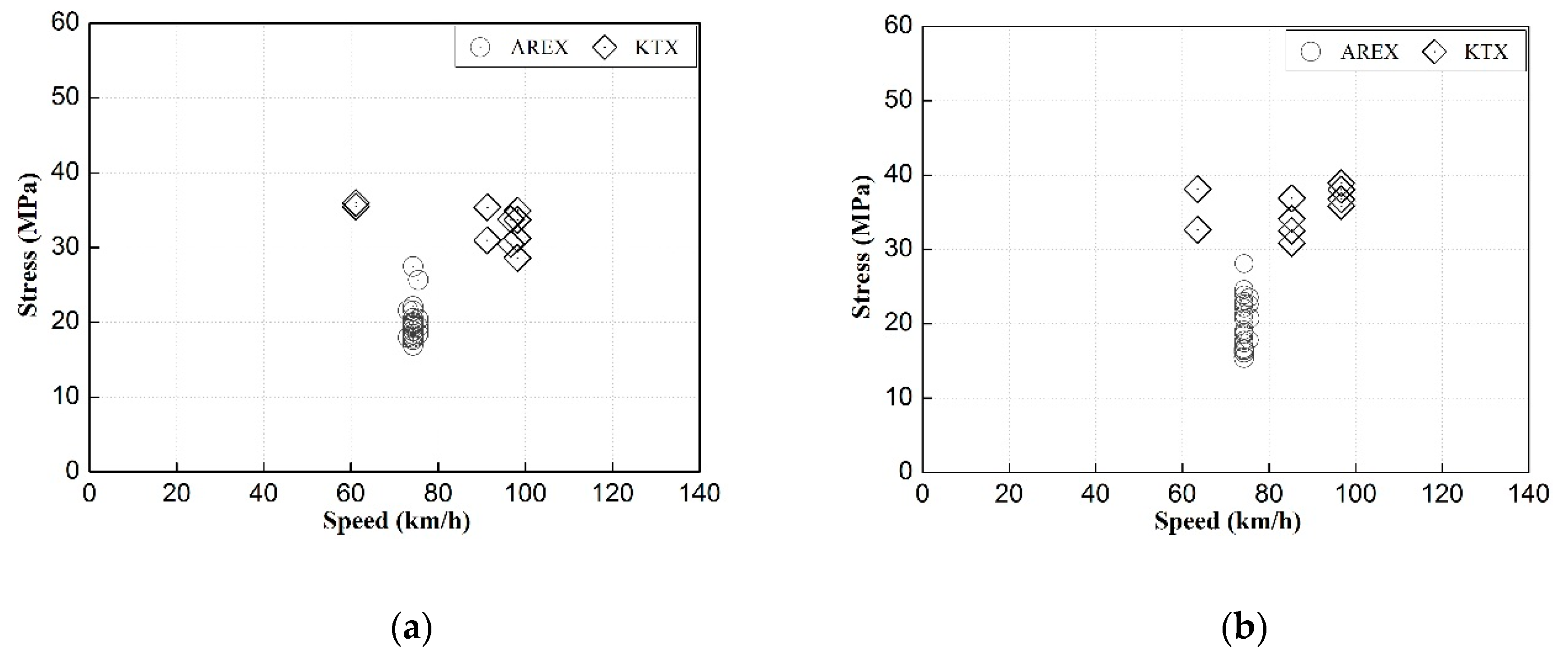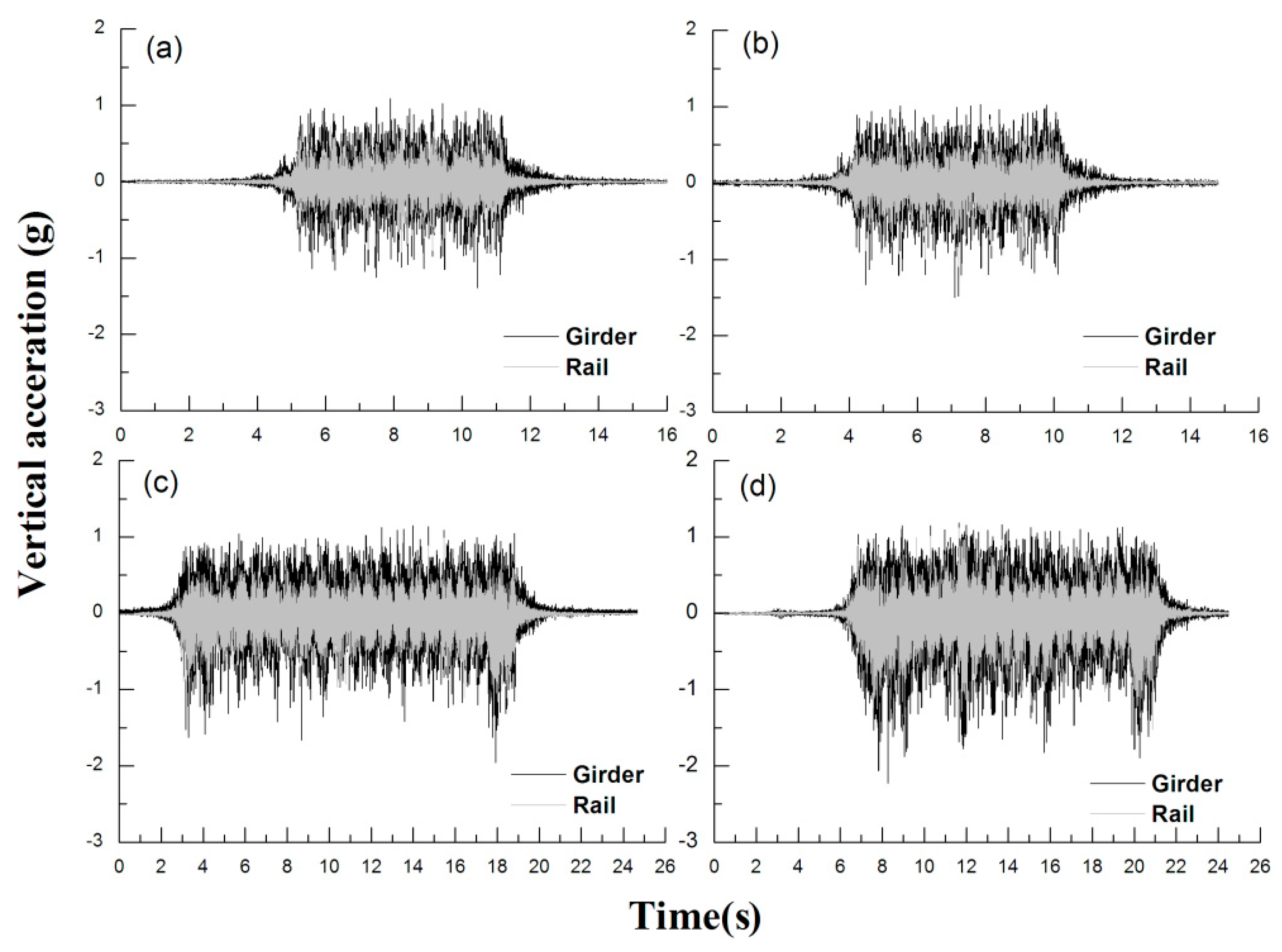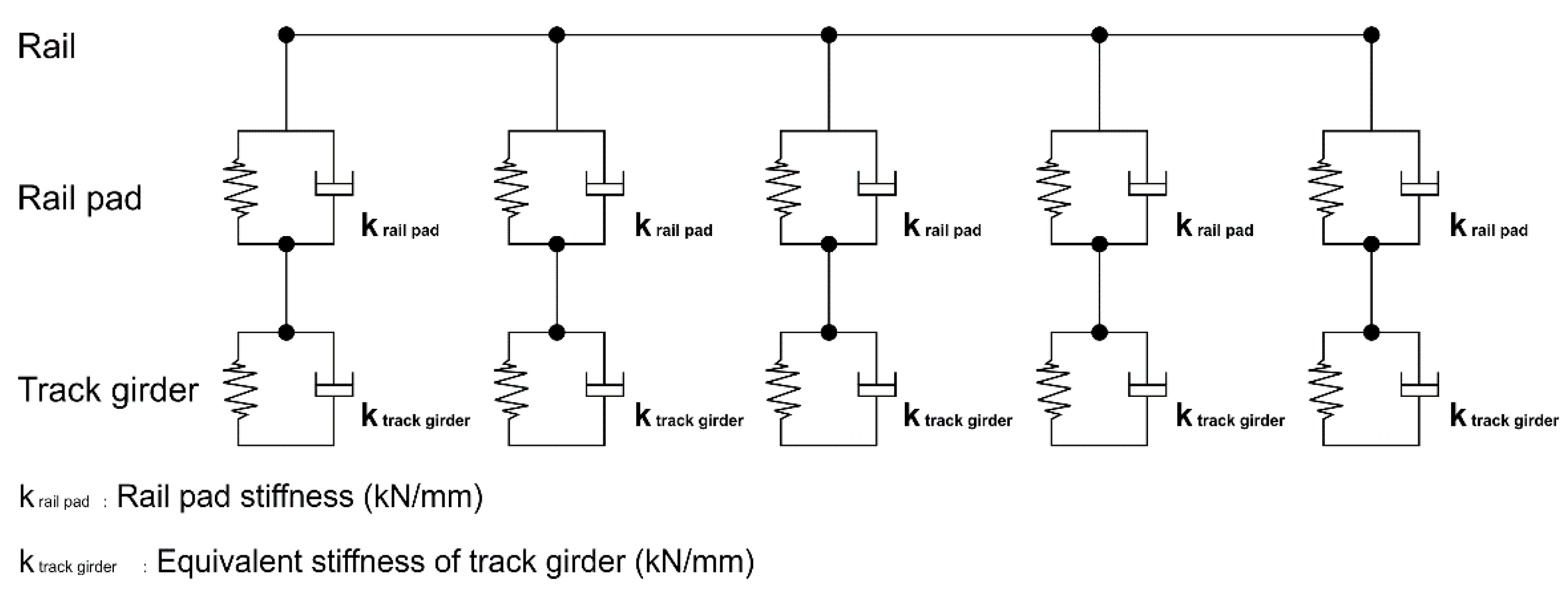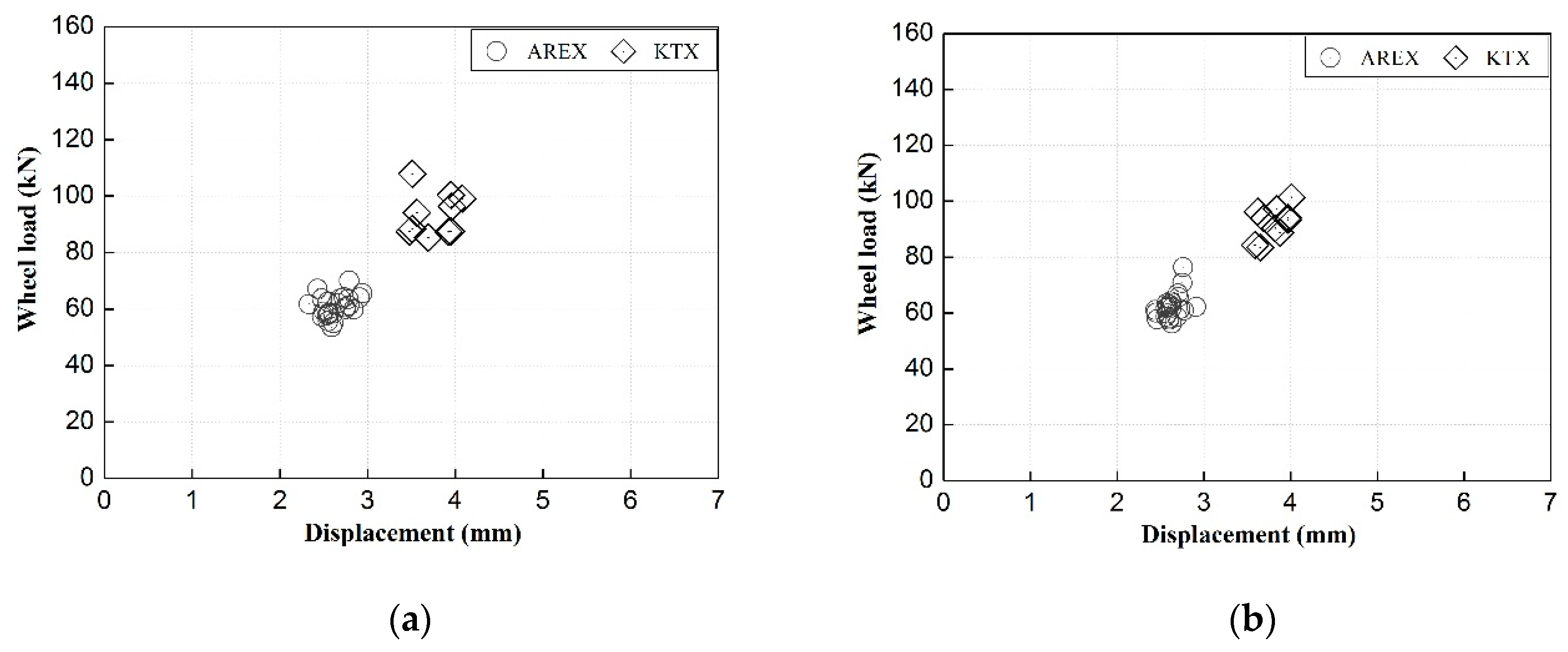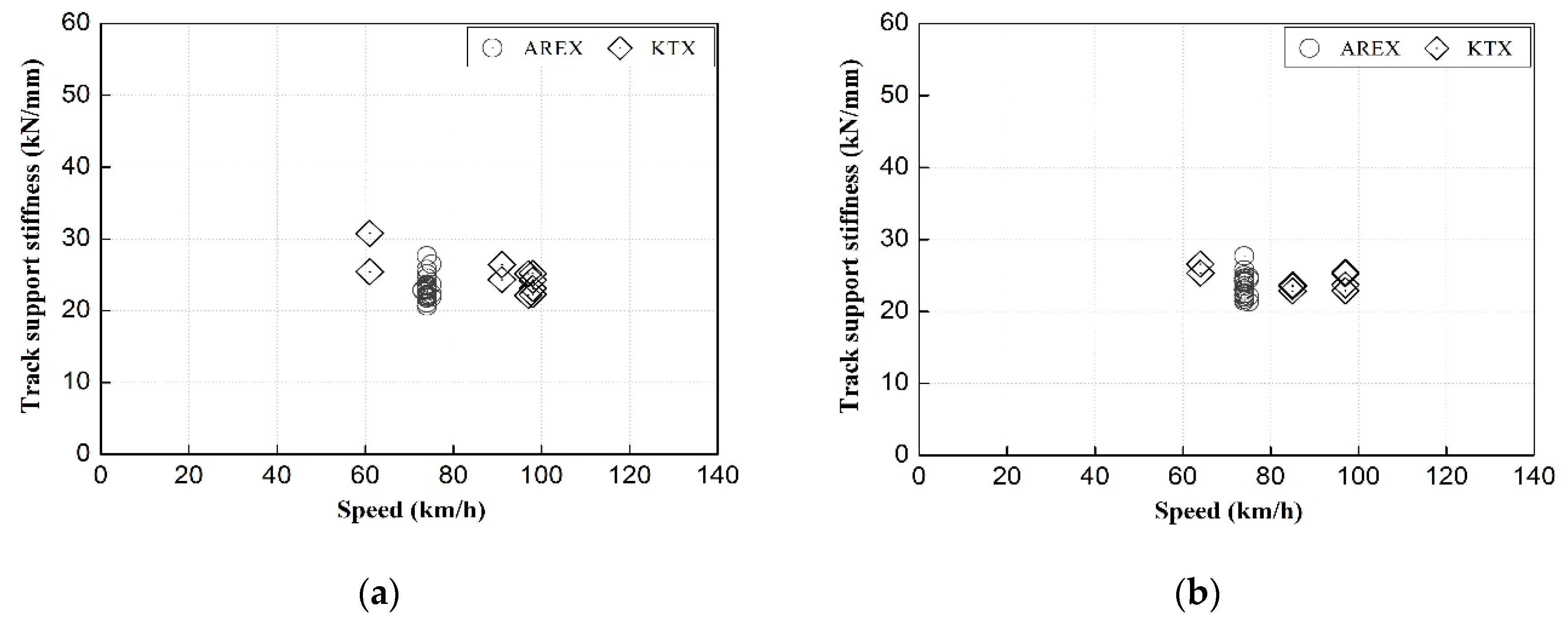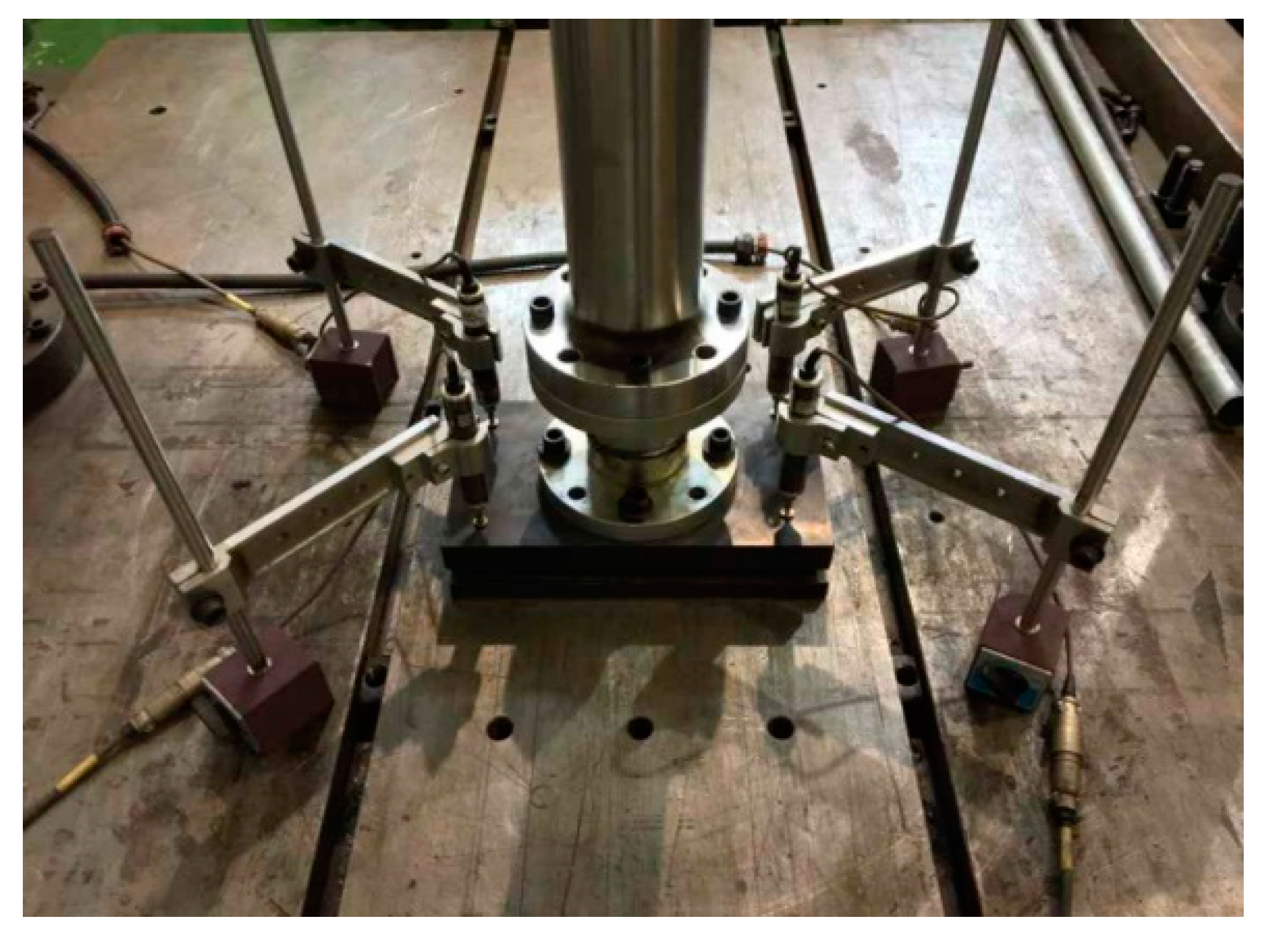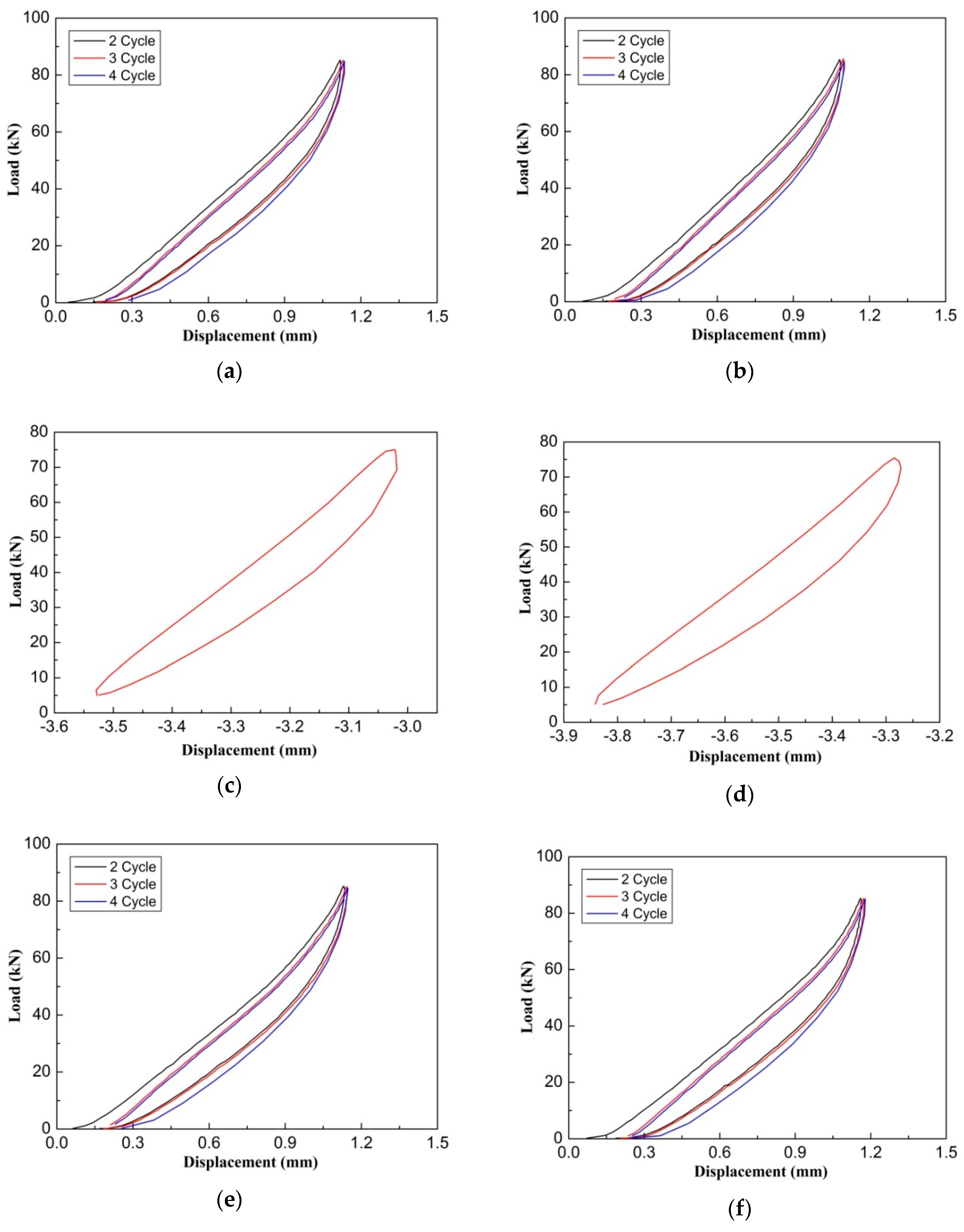1. Introduction
One of the main components in concrete track systems is the rail pad, which is installed between the rail and the sleeper to attenuate wheel/rail interaction loads This prevents the underlying railway sleepers from experiencing excessive stress [
1]. Soft pads are typically used for concrete tracks. However, the direct fixation track on the Yeongjong Grand Bridge uses hard pads. The direct-fixation track is the earliest form of track without ballast. This direct fixation track exhibits integrated behavior because the rail and track girder are rigidly connected together by the direct fixation rail fastening system. Moreover, the direct fixation track system of the Yeongjong Grand Bridge is attached to a long-span special bridge (cable and truss); this concept originated from the track style of the Great Seto Bridge in Japan [
2,
3]. It is the only such track type in South Korea, and currently condition assessments and maintenance of this track are challenging [
2,
3]. Other general types of direct fixation tracks have been widely deployed in recent years, and maintenance instructions will be required in the future. An important issue in the maintenance of both concrete slab tracks and direct fixation tracks is the timely replacement of the rail pads, commonly known as elastic pads (i.e., resilience pads and rail pads) [
4].
As shown in
Figure 1a, the track system on the Yeongjong Grand Bridge is installed with a direct fixation rail fastening system on upper flange of the track girder. Moreover, as shown in
Figure 1b, it is continuously arranged with simple supported beam-type track girders with a length of 12.5 m for supporting the rail. The rail weighs 60 kg with rail supporting point spacing of 0.625 m and the direct fixation track has a design speed of 110 km/h. The rail fastener of the direct fixation track is applied with a flat spring joint, a rail pad (SBR, styrene butadiene rubber), an adjustable pad, and the anti-loosening nut as shown in
Figure 1a [
2,
3].
In the previous research, it was estimated that the annual direct cost of corrosion in highway bridges in 2002 was
$8.3 billion, with indirect costs to users due to traffic delays and lost productivity, estimated to be 10 times. A significant portion of that cost can be tied directly to replacement costs for bridge decks, which are damaged principally due to corrosion of reinforced steel caused by deicing chemicals, primarily sodium chloride and calcium chloride [
5,
6]. Deterioration of bridge decks is a primary factor limiting the lifespan of bridges especially in cold climates where deicing salts are commonly used. While controlling deck cracking or decreasing the permeability and porosity of concrete can improve the performance and service life of bridges, chloride, and moisture ingress as well as cracking cannot be completely eliminated. Full-depth cracks, which are caused by restrained shrinkage, lead to corrosive conditions at early ages for both the top and bottom reinforcement mats [
7]. According to a study by Cope et al., the use of stainless steel elements as bridge deck reinforcements in a critical situation significantly increased the initial cost but significantly reduced the overall life-cycle cost, making it cost effective in the long term [
8]. In this study, the rail pad has a laminated structure. The upper surface is made of stainless steel and the lower surface is made of SBR material. SBR has a good abrasion resistance and good aging stability when protected by additives [
9]. The stainless steel on the top surface is in contact with the bottom of the rail and the SBR at the bottom is in contact with the adjustable pad. The stainless steel element was attached to the rail pads in order to mitigate the longitudinal interaction of the long-span railway bridge and direct the fixation track so that the longitudinal expansion of the continuous welded rail is relatively free. The original track of this bridge was designed as a rail-fastening system capable of acting in the longitudinal direction owing to concerns about the longitudinal bridge–track interaction force and expansion behavior, which could be observed using a rail pad with stainless steel. However, even though such rail pads were corroded, by installing a number of rail expansion joints in the bridge section to accommodate the expansion and contraction behavior in the rail, no structural problems occurred in the longitudinal direction. The stainless steel member attached to the rail pads was corroded in marine condition as shown in
Figure 2, and its appearance is concerned about whether the rail pads function properly.
In general, the track support stiffness of a direct fixation applied to concrete tracks can be calculated based on the deflection of the rail [
2]. The track support stiffness of a specified track structure using soft elastic pads can be directly affected by variations in the spring stiffness of the elastic pads. Variations in the spring stiffness of the elastic pads can also cause changes in the vehicle–track interaction force and the dynamic behavior of the entire track system [
4]. Therefore, in the case of typical concrete tracks, periodic and timely replacement of the rail pads is important for track maintenance [
2,
4,
10]. Lee [
11] experimentally assessed the effect of fatigue on the resilience pads of sleeper floating tracks in South Korea based on the prediction and assessment of changes in their spring stiffness. Park [
12] conducted simple fatigue tests on the elastic pads of a rail fastening system for concrete slab tracks, but a durability assessment based on simple fatigue could not properly reflect the actual field conditions. Lim et al. [
13] predicted the fatigue life of continuous welded rails using various parameters to calculate the rail replacement periods. They found that the rail bending fatigue life was reduced by approximately 32% when the pad stiffness decreased from 50 to 10 kN/mm, and that the rail bending fatigue life gradually converged to its maximum once the pad stiffness exceeded 200 kN/mm. It was found that rail pads with spring stiffness of greater than 200 kN/mm did not show any significant increase in spring stiffness with increasing service life. Therefore, the management of softer rail pads was important in terms of increasing the service life of the rail. Moreover, Lei and Zhang [
14] investigated the parameters of a concrete slab track that determine track vibration, such as the spring stiffness and damping properties from the rail pads, the cement–asphalt (CA) mortar, and the subgrade, in order to propose measures to reduce track vibration. The stiffness of the rail pads and the subgrade were found to be the factors governing track displacement, whereas the damping responses of the rail pads, CA mortar, and subgrade were not particularly influential. For track vibration, the influences of the spring stiffness and damping properties of rail pads were observed to be significant, whereas the effects attributed to the spring stiffness and the damping resulting from the CA mortar and the subgrade were able to be neglected [
14]. Additionally, Korama et al. [
15] investigated the effects of the preload and nonlinearity of rail pads on the vibration of a railway track under stationary and moving harmonic loads using the finite element method. They found that an increase in preload increased the dynamic spring stiffness of rail pads, and thus decreased the track displacement. Another study showed that direct fixation tracks on railway bridges can induce the integral behavior of the rail and the track girder (i.e., the rail support structure as a substructure) by using a harder rail pad, and that the elastic displacement of the rail of the direct fixation track is determined by the bending behavior of the track girder, which acts as a simple beam [
2]. Currently, there is no clear standard for the maintenance of rail pads used in direct fixation tracks, and no studies have been conducted on their behavioral characteristics. Moreover, no prior study has investigated either a) the deterioration characteristics of rail pads, or b) the necessity of their periodic replacement. Therefore, in this study, the influence of rail pads on the dynamic behaviors of the direct fixation track on a railway bridge was estimated using field measurements and laboratory tests. The results were used to determine the necessity of rail pad replacement and can be used to inform maintenance strategies for direct fixation tracks.
3. Laboratory Testing
The properties of the rail pad (SBR, styrene butadiene rubber) and assembly rail fastening system of the direct fixation track system of the Yeongjong Grand Bridge are presented in
Table 3.
The laboratory testing of this study examined the changes in the spring stiffness of new and used pads under static, dynamic, and aging spring stiffness tests. The appropriate rail pad replacement periods were also investigated in terms of their function and usability based on the observed changes in the spring stiffness of the rail pad.
Figure 16 shows the rail pad samples used in the laboratory testing, and
Table 4 lists the test conditions.
Static and dynamic vertical spring stiffness tests were conducted in accordance with the KRS (Korean Railway Standards) TR (track-rail) 0014-18(R) standard [
18]. In these tests, each rail pad was fixed on top of the loading plate as shown in
Figure 17. The zero-point setting was then performed after the linear variable differential transformers (LVDTs) were installed. The vertical displacement of the pad was measured at four points, and the results were used to prepare load–displacement curves. In the dynamic spring stiffness test, loading was performed 900 times in the 5–75 kN load range following a 4 Hz sine wave in accordance with KRS TR 0014-18(R) [
18].
Aging tests were also conducted to account for the change in the spring stiffness of general rail pads using experimental conditions that accelerate the deterioration of rubber materials.
The aging test is a type of acceleration deterioration test that investigates the deterioration in material properties when the sample is placed in a special environment over an extended period of time. The test outcomes allowed for the analyses of changes in the spring stiffness of the rail pads due to deterioration under environmental conditions during their use. In this study, the static spring stiffness of the new and used rail pads were measured as per the static spring stiffness test after aging the rail pads for 72 h at a temperature of 70 ± 1°C, as temperature is the most important factor for identifying aging characteristics from among the various deterioration factors in accordance with KRS TR 0014-18(R) [
18].
Figure 18 shows the load–displacement curves of the new and used pads obtained by the static, dynamic, and aging spring stiffness tests. As shown in
Table 5, the direct fixation track structure rail pads exhibited only small differences in spring stiffness between the new and used rail pad before and after being subjected to the aging test.
As shown in
Table 5, the differences between the static, dynamic, and aging spring stiffness test results for the new and used rail pads were found to be less than ±5% when subjected to an accumulated passing tonnage of 0.85 MGT. This indicates that the rail pads installed in the direct fixation track structure were not deformed or fractured by the temperature, period of use, or train load (accumulated passing tonnage).
Periodic replacement of soft rail pads is required to reduce track load and the damage caused by the deterioration of the rail pads. However, the rail pads of the direct fixation track system of the Yeongjong Grand Bridge evaluated in this study exhibited a displacement of approximately 0.5 mm when subjected to a load of 50 kN (static wheel load of AREX), and a displacement of approximately 0.94 mm when subjected to a load of 85 kN (static wheel load of KTX) based on the results of static spring stiffness tests. In contrast, the average displacement of the rail was 2.64 mm for AREX and 3.76 mm for KTX. The rail and track girder are coupled with the strong force of the fastener and exhibit integrated behavior [
3]. The actual displacement of the rail was found to be 0.11 mm for AREX and 0.20 mm for KTX. This indicates that the actual displacement of the rail pad due to the wheel load of a passing train would be much smaller than that measured in the laboratory test results. Therefore, it was determined that the hard rail pads of a direct fixation track system yield very small displacement under actual service load conditions, and that the effect of fatigue on their spring stiffness is not significant.
4. Conclusions
In this study, laboratory testing and field measurements were conducted to analyze the influence of the corroded rail pads of direct fixation tracks on the dynamic track response, and assess the necessity of corroded rail pad replacement in terms of spring stiffness of the rail pad according to the corrosion in marine condition. The conclusions are as follows:
1) Soft pads are generally used for concrete track. However, the direct fixation track on the Yeongjong Grand Bridge uses hard pads. In this study, the bridge behaved flexibly without using a soft pad. Therefore, the use of hard pads did not affect usability.
2) There was no obvious change observed in the track support stiffness or in the dynamic track response according to the replacement of the corroded rail pads. This indicates that the corroded rail pads with high spring stiffness do not change the track support stiffness as they corrode. In addition, the difference in vibration due to the rail pad replacement was found to be insignificant.
3) As the results of laboratory testing (static, dynamic, and aging spring stiffness tests), it investigated that the rail pads of direct fixation track on the Yeongjong Grand Bridge were not significantly affected by load and temperature (as applied via the aging test). In addition, when tested in the aging test under more adverse conditions than the field conditions, the rail pads did not exhibit any significant changes in their spring stiffness. This confirms that the rail pads installed in the direct fixation track were not affected by corrosion (environmental conditions), or the loading period (passing tonnage) during their use.
4) As the rail pads of the direct fixation track in the Yeongjong Grand Bridge have adequately high spring stiffness values, they did not exhibit any response to dynamic wheel load due to passing trains; thus, even if a hard rail pad was used for the track on the Yeongjong Grand Bridge, the elastic behavior of the track was ensured according to the flexible bending behavior of the track type. This indicates that such rail pads were made of SBR materials that were not directly affected by the corrosion and the passing tonnage. Therefore, for the rail pads in this study, even though the rail pads were corroded in appearance, there was no functional problem, so it was not necessary to replace it. Furthermore, further studies are needed to measure and evaluate the deterioration caused by corrosion of the rail pads.
